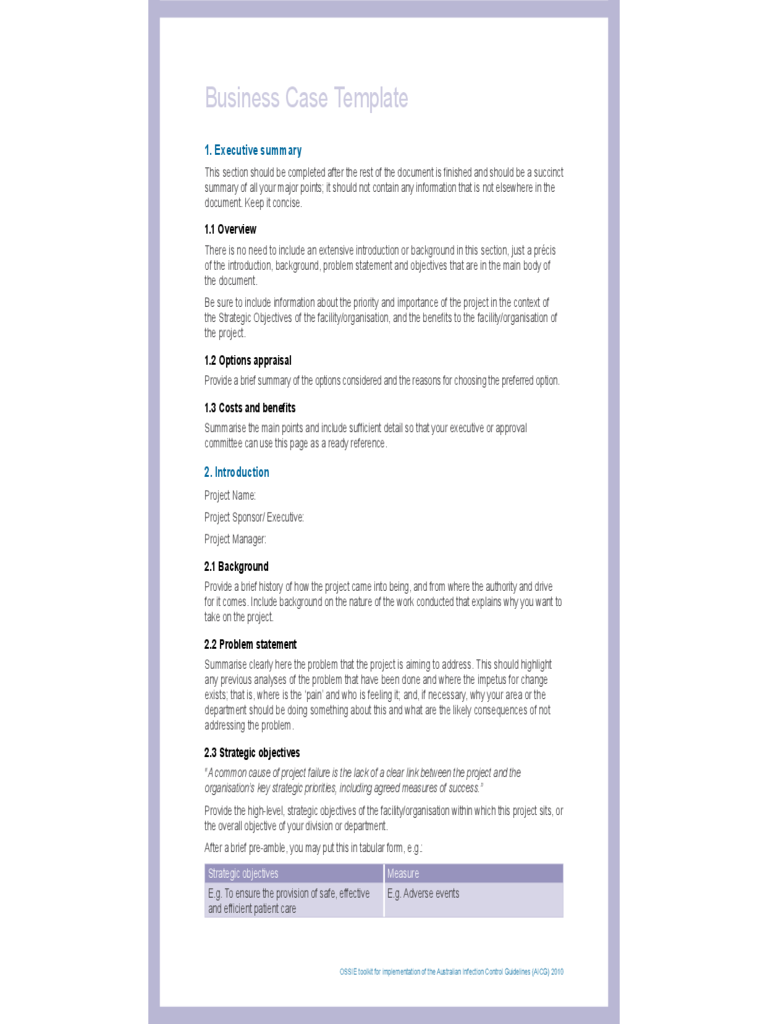Fillable Printable Sample Business Case Template
Fillable Printable Sample Business Case Template

Sample Business Case Template

OSSIE toolkit for implementation of the Australian Infection Control Guidelines (AICG) 2010
Business Case Template
1. Executive summary
This section should be completed after the rest of the document is nished and should be a succinct
summary of all your major points; it should not contain any information that is not elsewhere in the
document. Keep it concise.
1.1 Overview
There is no need to include an extensive introduction or background in this section, just a précis
of the introduction, background, problem statement and objectives that are in the main body of
the document.
Be sure to include information about the priority and importance of the project in the context of
the Strategic Objectives of the facility/organisation, and the benets to the facility/organisation of
the project.
1.2 Options appraisal
Provide a brief summary of the options considered and the reasons for choosing the preferred option.
1.3 Costs and benets
Summarise the main points and include sufcient detail so that your executive or approval
committee can use this page as a ready reference.
2. Introduction
Project Name:
Project Sponsor/ Executive:
Project Manager:
2.1 Background
Provide a brief history of how the project came into being, and from where the authority and drive
for it comes. Include background on the nature of the work conducted that explains why you want to
take on the project.
2.2 Problem statement
Summarise clearly here the problem that the project is aiming to address. This should highlight
any previous analyses of the problem that have been done and where the impetus for change
exists; that is, where is the ‘pain’ and who is feeling it; and, if necessary, why your area or the
department should be doing something about this and what are the likely consequences of not
addressing the problem.
2.3 Strategic objectives
“A common cause of project failure is the lack of a clear link between the project and the
organisation’s key strategic priorities, including agreed measures of success.”
Provide the high-level, strategic objectives of the facility/organisation within which this project sits, or
the overall objective of your division or department.
After a brief pre-amble, you may put this in tabular form, e.g.:
Strategic objectives Measure
E.g. To ensure the provision of safe, effective
and efcient patient care
E.g. Adverse events

OSSIE toolkit for implementation of the Australian Infection Control Guidelines (AICG) 2010
2.4 Project objectives
The project objectives highlight the products that are to be produced as a result of this project.
2.5 Related projects
Briey state any other projects that are being undertaken that relate to the same strategic. Be sure
to highlight whether there are interdependencies between this project and any of those projects.
3. Options analysis
You may be required to consider more than one option to achieve improvements in IP&C, and this
section should contain an analysis of the options plus the ‘do-nothing’ option. Insert a description of
each option considered, then include full details and analysis of all options in an Appendix.
1. Option 1 – do nothing ...
2. Option 2 –
3. Option 3 –
The following table summarises the comparisons of all options considered.
3.1 Preferred option
State the preferred option and why.
Options comparison
Option 1 – <short
description>
Option 2 – <short
description>
Option 3 – <short
description>
Benets
Benets of each option
(see APIC guide for advice on
this).
Disadvantages
List the negative consequences
of each option.
Timescale
Over what period will the costs
be incurred and over what
period will the benets occur.
Costs
Summarise the costs and
supporting assumptions
associated with each option,
including ongoing costs.
Major Risks
Provide a summary of the
aggregated risk ratings,
highlighting the major risks
that will have an effect on the
business objectives and benets.

OSSIE toolkit for implementation of the Australian Infection Control Guidelines (AICG) 2010
4. Procurement
State what procurement action would need to be undertaken. Include an indicative timetable and
justication for the proposed approach.
5. Project strategy
Key milestones and deliverables
The key milestones will be presented in a table, as follows:
Event / Milestone Deliverable Date
(or elapsed time from start
of project)
6. Costs – benet analysis
Refer to the advice in the APIC guide to prepare this.
Outline how calculations for savings and benets have been made – include attributable costs.
7. Project management and control
7.1 Business case
Write a brief statement on how this document will be kept up to date during the course of the
project; that is, review points particularly where the expected scope, costs, benets and savings
gures are re-adjusted or conrmed. How will different versions be identied?
7.2 Governance
This section outlines the project management structure that you will use to manage the project Make
sure you cover at least the following points:
● Who will oversee progress (E.g. committee, executive sponsor, divisional head)
● Who will manage the project?
● How will the facility executive be kept informed of progress?
7.3 Risk management
Check the organisational risk assessment tools and policy to undertake a risk assessment of each
of the options
7.4 Progress monitoring
Enter here the mechanisms that you will establish to monitor and compare actual achievements
against your baseline plan.



